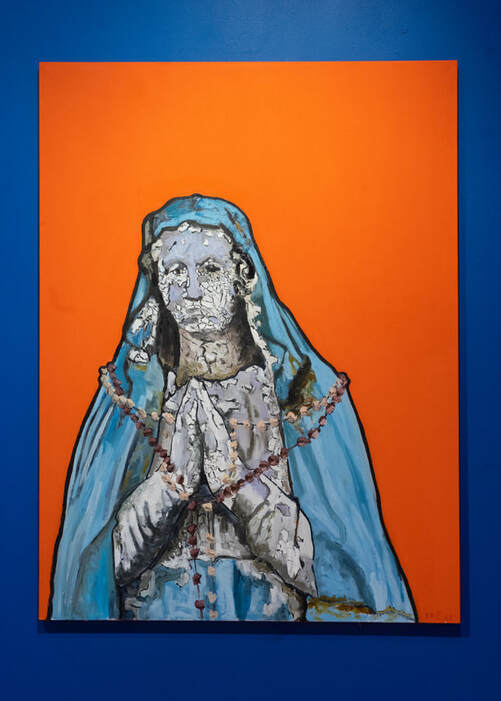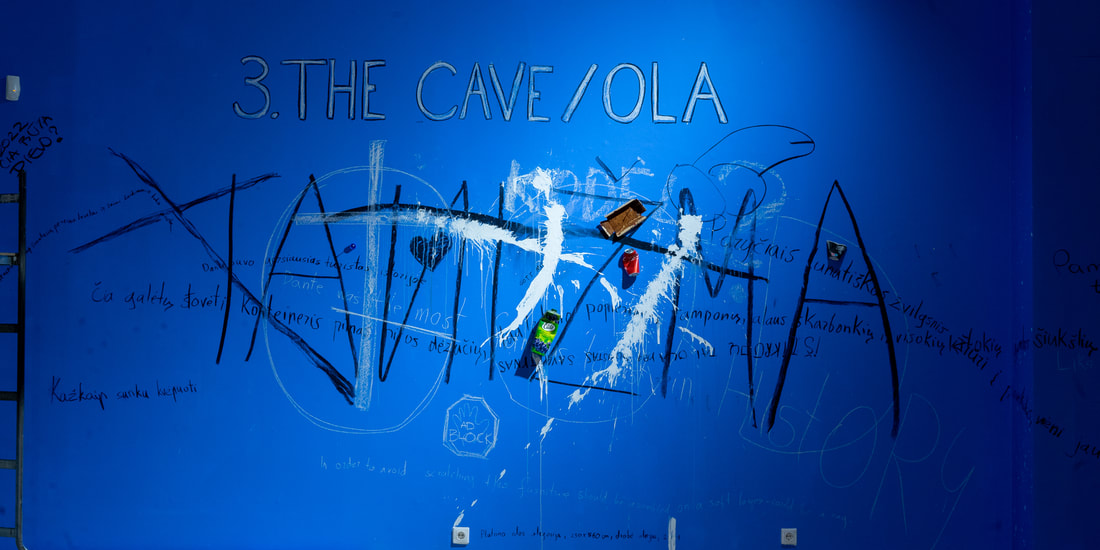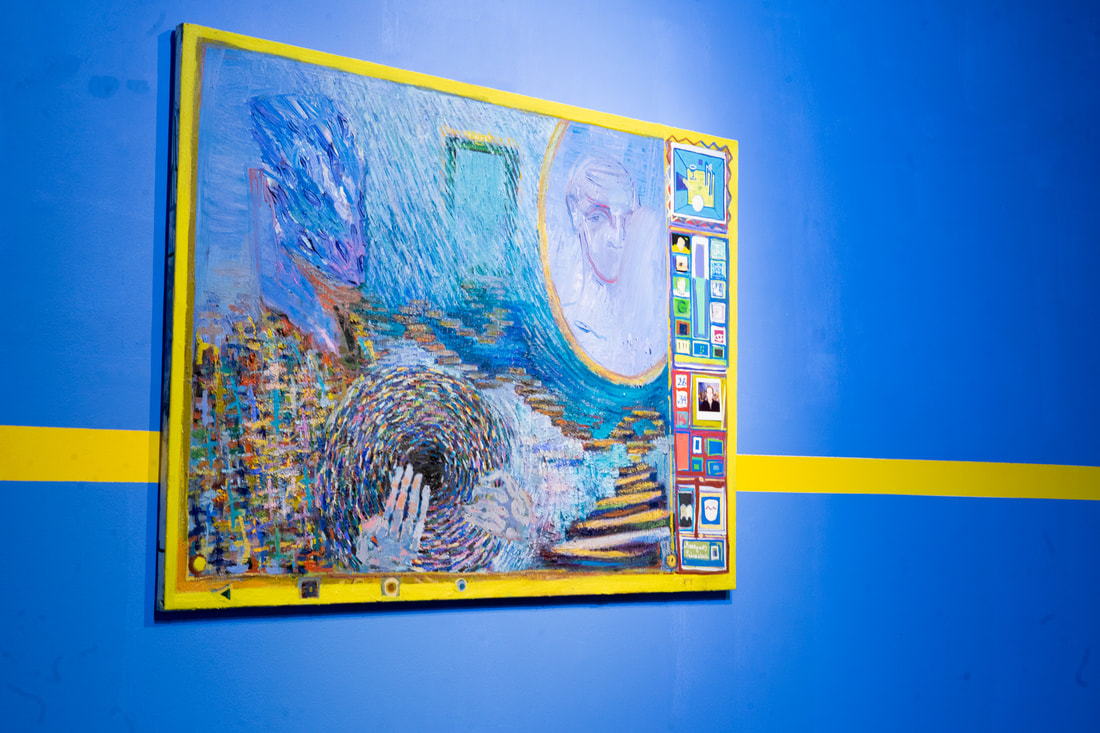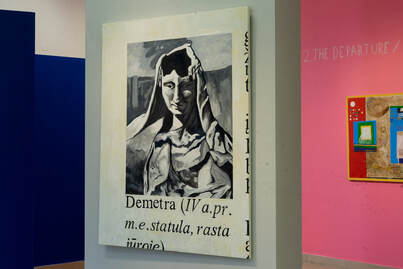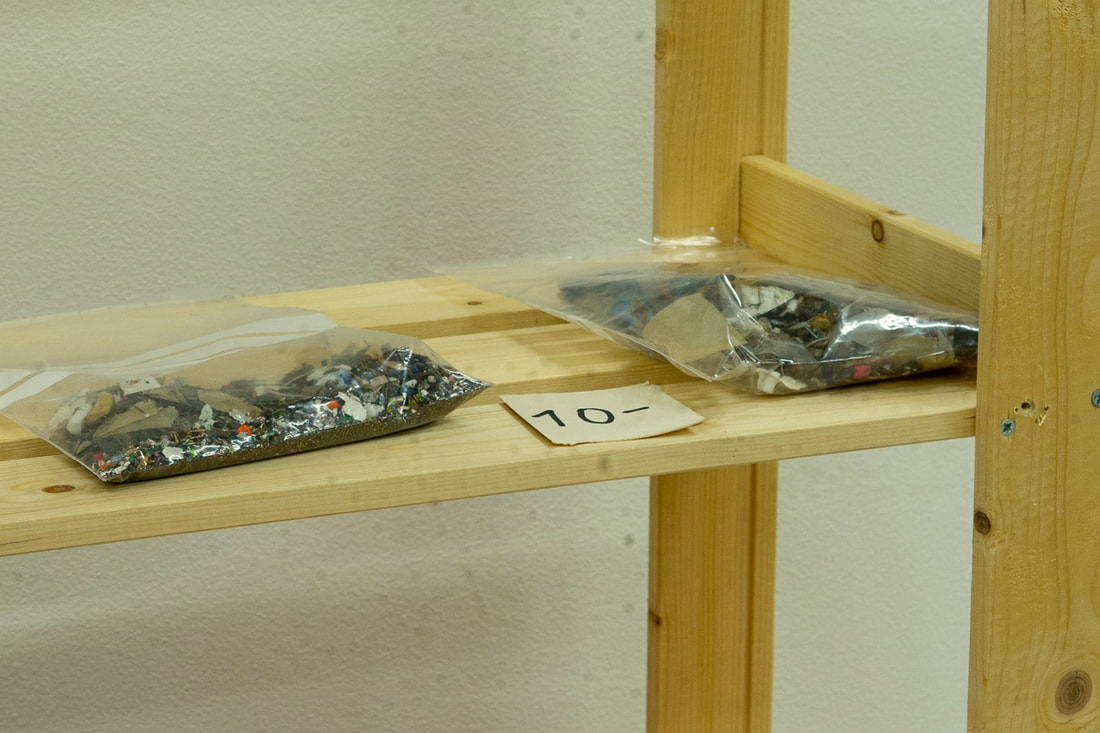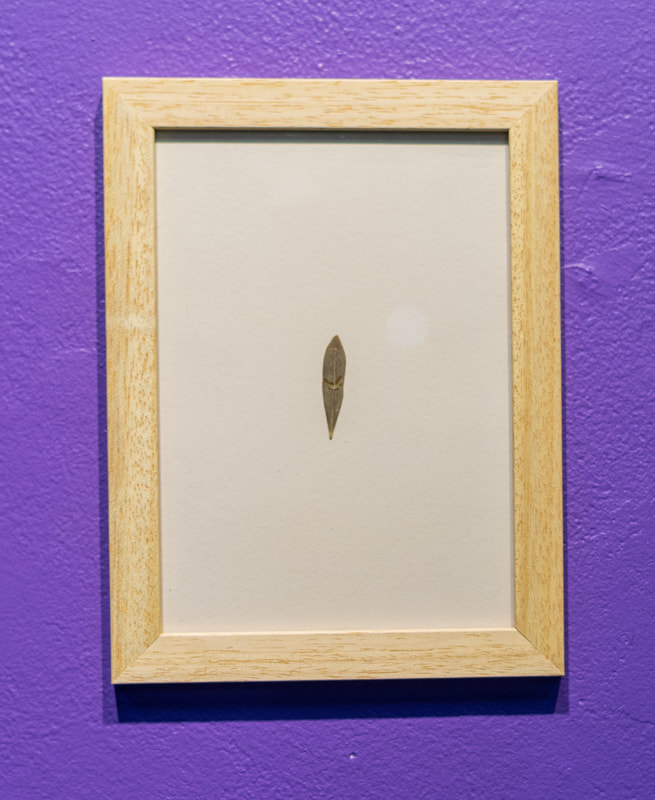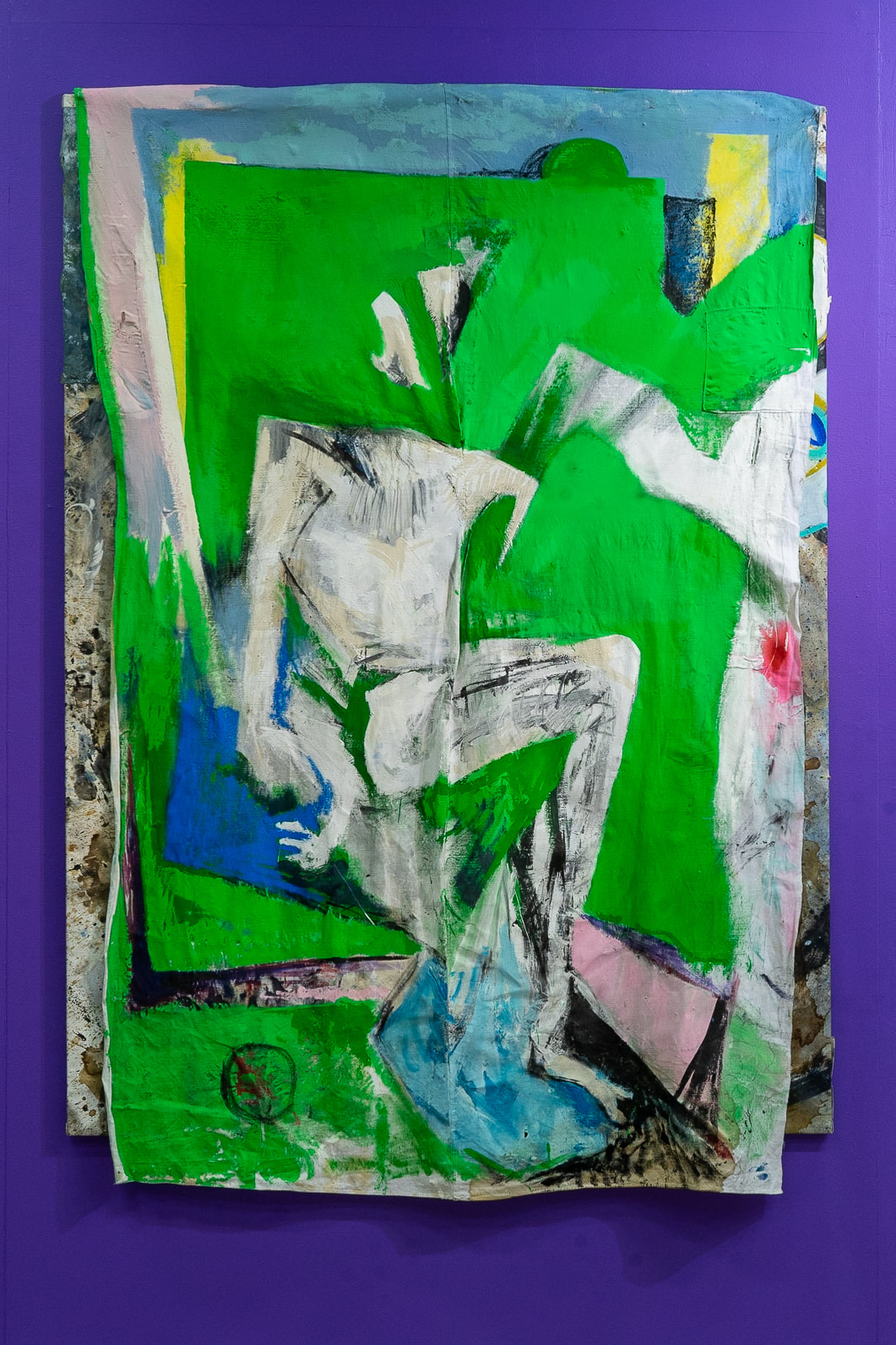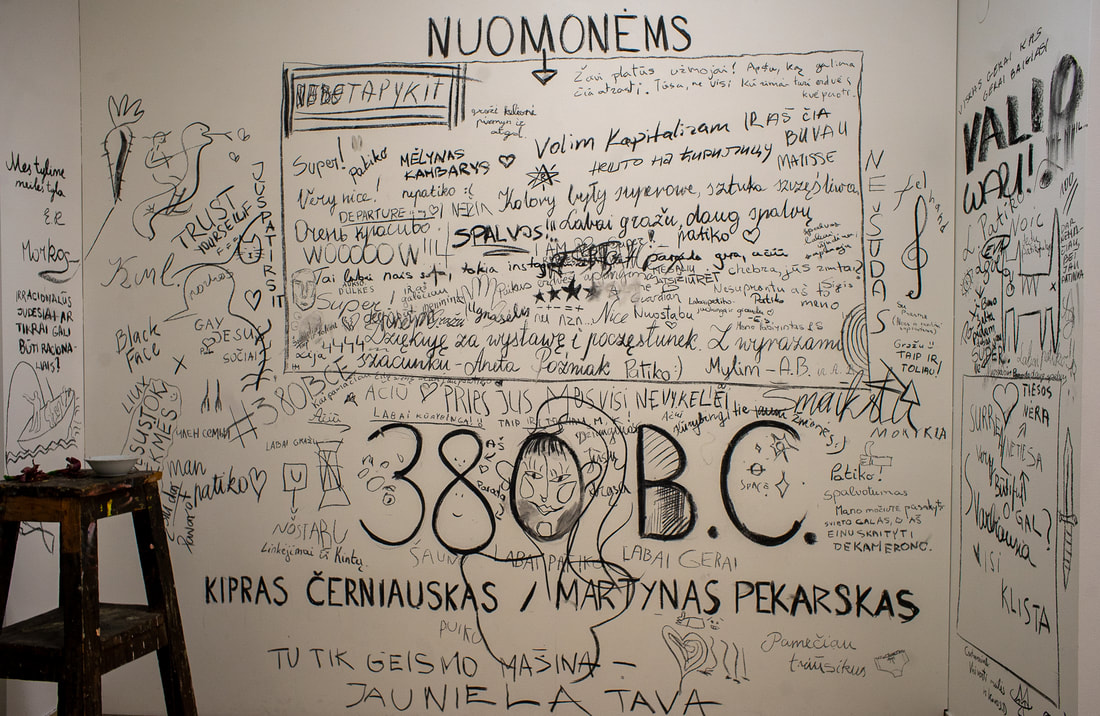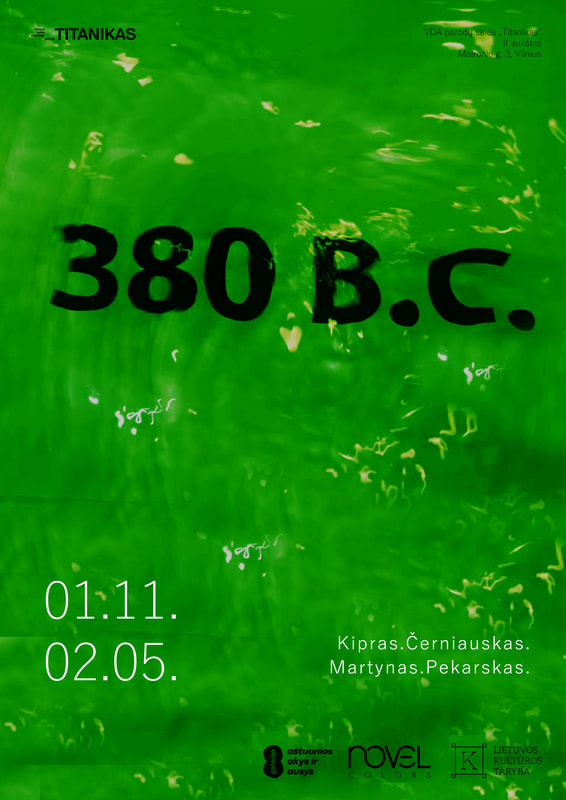THE CAVE / OLA
RATIONALIZATION / RACIONALIZACIJA
[LT]
Jau seniai, nuo buvimo Juodkalnijoje laikų, mano galvoje sukasi mintys apie požemių ir urvų tapybą. Pradžioje tai buvo susižavėjimas įspūdingomis urvų sistemomis su milžiniškais įėjimais. Juodkalnijoje mudu su Ieva daug keliavome (hike‘inome), labai žavėjo, jog toje šalyje yra išlikę senoviniai akmeniniai prekybos keliai per kalnus, miškus ir pievas pajūryje bei šalies gilumoje. Labai žavėjo ir tebežavi pats keliavimo procesas, kai beeinant viskas keičiasi, lipant į kalną mažėja medžių, darosi šalčiau, daugėja atvirų uolų, akmenų, o viršukalnėje pasirodo sniegas. Po ilgo kopimo pasimato nesuvokiami toliai – štai nuo vienos viršukalnės giedromis dienomis galima įžvelgti jūrą bei Italiją kitoje jos pusėje, kuri yra daugiau nei už 100 kilometrų. Po to seka lipimas žemyn link pakrantės, takas veda per spygliuočių mišką, lyja, dar žemiau lietus dingsta, atsiranda tirštas rūkas, žemyn teka kalnų upelis su kriokliais. Dar žemiau spygliuočiai praretėja, o lapuočiai, viršuje buvę rudeniški ir be lapų, sužaliuoja. Temperatūra kyla, takelio pakraščiuose atsiranda žydinčios gėlės, debesys prasisklaido, išlenda saulė. Tolumoje atsiveria įlanka Adrijos jūroje su mažyčiais taškučiais-laivais, mašinomis bei pastatais. Dar pasileidus, eiti pasidaro karšta, randasi vijokliai, tujos, kiparisai, įvairūs spygliuoti Viduržemio jūros regiono augalai. Šliaužioja gyvatės, galima aptikti skorpionus ir vėžlius. Nusileidus iki miestuko pakrantėje įspūdingu serpentinu, atsiranda ir palmės, uoste stovi kruizinis laivas. Visi šie pasikeitimai atsitinka per vieną dieną – nuo sniego iki palmių, einant tais pačiais senoviniais prekybos keliukais. Širdyje įsižiebia tyrinėjimo, pažinimo troškimas bei didžiulė nuostaba.
Atėjus tokį kelią, galima matyti turkio spalvos jūros bangas, besitaškančias į pakrantės uolas. Tarp tų uolų plyti angos į požeminius urvus, pro kuriuos teka upės, auga stalaktitai ir stalagmitai, gyvena įvairūs keisti tamsos padarai. Tokių urvų galima aptikti visoje šalyje, nebūtinai prie jūros. Į vieną tokį atkeliavus tenka lipti milžiniškais akmenimis, po kiek laiko dingsta šviesa, lieki visiškoje tamsoje, visur sklando drėgnos dulkės, darosi sunku kvėpuoti, urvas leidžiasi gilyn. Kažkur apačioje girdisi požeminės upės šniokštimas. Norom nenorom į galvą ateina antikiniai mitai apie Hado karalystę, Stikso upę, keltininką, Dantę. Atrodytų natūralu, kad visa įspūdžių pilna kelionė pasibaigia čia, prie mirusiųjų upės. Darosi labai šalta ir baisu. Toliau leistis nesinori, tačiau smalsumas išlieka.
Teko apeiti daugybę tokių urvų, kai kurie – labai laukiniai, kai kurie – su žmogaus veiklos pėdsakais, o vienas netgi pritaikytas turizmui, su apšvietimu, gidais, ekskursijom, koncertais.
Visa ši patirtis kartu su „DEKAMERONO“ serijos kūrimu atvedė mane iki idėjos „Kelias į Hado karalystę“, kas yra mano būsimas projektas. Bevystydamas Hado karalystės idėją, paraleliai pradėjau tapyti darbus apie įsivaizduojamą, pamirštą šventumą. Pradėjau rinkti sulūžusių, senų, kerpėmis apaugusių religinių skulptūrų vaizdus. Savotiškas „DEKAMERONO“ epilogas ir „Hado karalystės“ prologas. Darau tai su siekiu permąstyti krikščionybės idėjas šiuolaikinėje šviesoje, prisiminti tai, kas pamiršta ir šiandien suprantama labai primityviai bei dažnai prilyginama „blogiui“. Keliu idėją, kad galbūt neprimityviai suprantama krikščionybė galėtų eiti kartu su visais socialiniais pasikeitimais bei žmogaus teisėmis. Pats esu ateistas, tačiau man labai patinka krikščionybė, nes, mano nuomone, iš to, ką žinau – ji labai gerai paaiškina tai, kas yra žmogus ir kodėl jis elgiasi vienaip ar kitaip.
Čia ateina Platono urvo alegorija. Filosofiškai, šopenhaueriškai pasakius – pasaulis yra vaizdinys be laisvos valios, budistiškai pasakius – mes gyvename uždarame, troškimų valdomame reinkarnacijų rate ir nesugebame pamatyti, jog visa yra vienis, hinduistiškai pasakius – viską dengia Majos skraistė, krikščioniškai pasakius – mes nešiojamės prigimtinę nuodėmę ir jos atsikratyti galime tik per išganymą, baudrilardiškai pasakius – gyvename tarp simuliakrų, biologiškai pasakius – mes esame valdomi dopamino, visa tai išvertus reiškia, jog mes matome tik subjektyviai ir negebame patirti objektyvios realybės. Platonas kalba apie urvą, kuriame mes esame surakinti kaliniai, nematantys saulės ir pačių daiktų, o tik jų praeinančius šešėlius nuo laužo šviesos.
Visi šie įvaizdžiai kalba apie iliuziškumą. Galima būtų sakyti, jog visas dvidešimtas amžius buvo pilnas iliuzijų, netikrumo, greičio, subjektyvumo, tačiau greitis vis didėja, jis nesustabdomas, mes jau nebegalime jo niekaip sukontroliuoti. Riba tarp tikros realybės ir menamos realybės jau dabar yra dingusi. Išgyventi šitokiame pasaulyje ilgą laiką mums padėjo ironija – kadangi mes žinom, jog tiesos negali būti, mes nieko nebetraktuojame rimtai. Tačiau kartu su netikrumo mūsų gyvenimuose augimu auga ir tikrumo ilgesys. Ironija, nors ir puiki apsauga, palengva ima varginti, erzinti žmogų bei netenka savo galios. Kažkuriuo momentu įvyks lūžis ir neištvėręs įtampos žmogus susprogs naivioje, emocingoje jausmų isterijoje ir vėl bandys susikurti atmestas tiesas, kad ir kokios neteisingos jos būtų.
Štai ir dvi idėjos atsiradimo pusės – viena emocinė, iracionali, t.y. gamtos grožis ir įspūdis, asmeninis išgyvenimas, ir kita, kuri yra paremta daugybe idėjų, kurios kitais žodžiais ir skirtingais laikotarpiais, skirtingose kultūrinėse sąlygose sako tą patį ar bent jau galėtų būti interpretuojamos kaip tos pačios monetos pusės, taip pat – laiko dvasia ir ateities prognozės. Dvi paveikslo pusės – emocinė ir idėjinė – susitinka.
Išeidami nepamirškite užsukti į dovanų krautuvėlę.
Jau seniai, nuo buvimo Juodkalnijoje laikų, mano galvoje sukasi mintys apie požemių ir urvų tapybą. Pradžioje tai buvo susižavėjimas įspūdingomis urvų sistemomis su milžiniškais įėjimais. Juodkalnijoje mudu su Ieva daug keliavome (hike‘inome), labai žavėjo, jog toje šalyje yra išlikę senoviniai akmeniniai prekybos keliai per kalnus, miškus ir pievas pajūryje bei šalies gilumoje. Labai žavėjo ir tebežavi pats keliavimo procesas, kai beeinant viskas keičiasi, lipant į kalną mažėja medžių, darosi šalčiau, daugėja atvirų uolų, akmenų, o viršukalnėje pasirodo sniegas. Po ilgo kopimo pasimato nesuvokiami toliai – štai nuo vienos viršukalnės giedromis dienomis galima įžvelgti jūrą bei Italiją kitoje jos pusėje, kuri yra daugiau nei už 100 kilometrų. Po to seka lipimas žemyn link pakrantės, takas veda per spygliuočių mišką, lyja, dar žemiau lietus dingsta, atsiranda tirštas rūkas, žemyn teka kalnų upelis su kriokliais. Dar žemiau spygliuočiai praretėja, o lapuočiai, viršuje buvę rudeniški ir be lapų, sužaliuoja. Temperatūra kyla, takelio pakraščiuose atsiranda žydinčios gėlės, debesys prasisklaido, išlenda saulė. Tolumoje atsiveria įlanka Adrijos jūroje su mažyčiais taškučiais-laivais, mašinomis bei pastatais. Dar pasileidus, eiti pasidaro karšta, randasi vijokliai, tujos, kiparisai, įvairūs spygliuoti Viduržemio jūros regiono augalai. Šliaužioja gyvatės, galima aptikti skorpionus ir vėžlius. Nusileidus iki miestuko pakrantėje įspūdingu serpentinu, atsiranda ir palmės, uoste stovi kruizinis laivas. Visi šie pasikeitimai atsitinka per vieną dieną – nuo sniego iki palmių, einant tais pačiais senoviniais prekybos keliukais. Širdyje įsižiebia tyrinėjimo, pažinimo troškimas bei didžiulė nuostaba.
Atėjus tokį kelią, galima matyti turkio spalvos jūros bangas, besitaškančias į pakrantės uolas. Tarp tų uolų plyti angos į požeminius urvus, pro kuriuos teka upės, auga stalaktitai ir stalagmitai, gyvena įvairūs keisti tamsos padarai. Tokių urvų galima aptikti visoje šalyje, nebūtinai prie jūros. Į vieną tokį atkeliavus tenka lipti milžiniškais akmenimis, po kiek laiko dingsta šviesa, lieki visiškoje tamsoje, visur sklando drėgnos dulkės, darosi sunku kvėpuoti, urvas leidžiasi gilyn. Kažkur apačioje girdisi požeminės upės šniokštimas. Norom nenorom į galvą ateina antikiniai mitai apie Hado karalystę, Stikso upę, keltininką, Dantę. Atrodytų natūralu, kad visa įspūdžių pilna kelionė pasibaigia čia, prie mirusiųjų upės. Darosi labai šalta ir baisu. Toliau leistis nesinori, tačiau smalsumas išlieka.
Teko apeiti daugybę tokių urvų, kai kurie – labai laukiniai, kai kurie – su žmogaus veiklos pėdsakais, o vienas netgi pritaikytas turizmui, su apšvietimu, gidais, ekskursijom, koncertais.
Visa ši patirtis kartu su „DEKAMERONO“ serijos kūrimu atvedė mane iki idėjos „Kelias į Hado karalystę“, kas yra mano būsimas projektas. Bevystydamas Hado karalystės idėją, paraleliai pradėjau tapyti darbus apie įsivaizduojamą, pamirštą šventumą. Pradėjau rinkti sulūžusių, senų, kerpėmis apaugusių religinių skulptūrų vaizdus. Savotiškas „DEKAMERONO“ epilogas ir „Hado karalystės“ prologas. Darau tai su siekiu permąstyti krikščionybės idėjas šiuolaikinėje šviesoje, prisiminti tai, kas pamiršta ir šiandien suprantama labai primityviai bei dažnai prilyginama „blogiui“. Keliu idėją, kad galbūt neprimityviai suprantama krikščionybė galėtų eiti kartu su visais socialiniais pasikeitimais bei žmogaus teisėmis. Pats esu ateistas, tačiau man labai patinka krikščionybė, nes, mano nuomone, iš to, ką žinau – ji labai gerai paaiškina tai, kas yra žmogus ir kodėl jis elgiasi vienaip ar kitaip.
Čia ateina Platono urvo alegorija. Filosofiškai, šopenhaueriškai pasakius – pasaulis yra vaizdinys be laisvos valios, budistiškai pasakius – mes gyvename uždarame, troškimų valdomame reinkarnacijų rate ir nesugebame pamatyti, jog visa yra vienis, hinduistiškai pasakius – viską dengia Majos skraistė, krikščioniškai pasakius – mes nešiojamės prigimtinę nuodėmę ir jos atsikratyti galime tik per išganymą, baudrilardiškai pasakius – gyvename tarp simuliakrų, biologiškai pasakius – mes esame valdomi dopamino, visa tai išvertus reiškia, jog mes matome tik subjektyviai ir negebame patirti objektyvios realybės. Platonas kalba apie urvą, kuriame mes esame surakinti kaliniai, nematantys saulės ir pačių daiktų, o tik jų praeinančius šešėlius nuo laužo šviesos.
Visi šie įvaizdžiai kalba apie iliuziškumą. Galima būtų sakyti, jog visas dvidešimtas amžius buvo pilnas iliuzijų, netikrumo, greičio, subjektyvumo, tačiau greitis vis didėja, jis nesustabdomas, mes jau nebegalime jo niekaip sukontroliuoti. Riba tarp tikros realybės ir menamos realybės jau dabar yra dingusi. Išgyventi šitokiame pasaulyje ilgą laiką mums padėjo ironija – kadangi mes žinom, jog tiesos negali būti, mes nieko nebetraktuojame rimtai. Tačiau kartu su netikrumo mūsų gyvenimuose augimu auga ir tikrumo ilgesys. Ironija, nors ir puiki apsauga, palengva ima varginti, erzinti žmogų bei netenka savo galios. Kažkuriuo momentu įvyks lūžis ir neištvėręs įtampos žmogus susprogs naivioje, emocingoje jausmų isterijoje ir vėl bandys susikurti atmestas tiesas, kad ir kokios neteisingos jos būtų.
Štai ir dvi idėjos atsiradimo pusės – viena emocinė, iracionali, t.y. gamtos grožis ir įspūdis, asmeninis išgyvenimas, ir kita, kuri yra paremta daugybe idėjų, kurios kitais žodžiais ir skirtingais laikotarpiais, skirtingose kultūrinėse sąlygose sako tą patį ar bent jau galėtų būti interpretuojamos kaip tos pačios monetos pusės, taip pat – laiko dvasia ir ateities prognozės. Dvi paveikslo pusės – emocinė ir idėjinė – susitinka.
Išeidami nepamirškite užsukti į dovanų krautuvėlę.
Broken Christ
280x220 cm, oil on canvas, 2021
[EN]
For a long time, since being in Montenegro, there are thoughts about painting undergrounds and caves flowing in my mind. At first it was just an admiration of spectacular systems of caves with enormous entrances. Me and Ieva hiked a lot in Montenegro and we were fascinated by these rocky ancient trade roads that still remain near the seaside as well as at the depth of the country and lead through the mountains, forests and meadows. I was and still am fascinated by the travelling process itself, when everything changes as you go, when going up the mountain there are less and less trees left, it becomes colder, rocks and stones become plain and uncovered and the snow starts to show up. After a long climb, incomprehensible distances show up and here you are at the top of the mountain. If the day is clear, you can see the sea and Italy on the other side of it, which is more than 100 kilometres away. Then you start to get down towards the coast, a path leads through the coniferous forest, it rains, downwards the rain stops and thick fog shows up, a mountain stream with waterfalls flows down. Going further, the conifers become infrequent and deciduous trees, that were autumnish and leafless at the top, now get greener. The temperature gets higher, blooming flowers start to show up at the side of the path, clouds clear away and the sun shows up. In the distance, a gulf starts to show up in the Adriatic Sea with these little dots-ships, cars and buildings. Further down it becomes hot to walk and bindweeds, thujas, cypresses, various conifers and plants of Mediterranean region appear. Snakes slither and it is possible to come across scorpions and turtles. After reaching the town by the shore while going down impressive serpentine, palm trees and a cruise ship in the port appear. All these changes happen during one day – from snow until palm trees, and everything while travelling through the same ancient trade roads. The heart lights up with a desire for exploration, knowledge and a huge astonishment.
After travelling such road, you can see the turquoise sea waves splashing into the rocks of the coast. In between those rocks there are underground caves that the rivers flow through, stalactites and stalagmites grow and various strange creatures of the dark live. These caves can be discovered throughout the whole country, not necessarily in the seaside. There is one like that which is reached by climbing huge rocks – after a while the light disappears and you find yourself in complete darkness, there are wet dust everywhere, it becomes hard to breathe and the cave goes downwards. Somewhere in the distance you can hear an underground river wheezing. Perforce the thoughts of antique myths about Hades kingdom, river Styx, the rafter and Dante appear in the head. It seems natural that all this journey full of impressions ends exactly here – near the river of the dead. It becomes very cold and scary. It doesn‘t seem pleasant to go deeper yet the curiosity remains. There were plenty of caves that we had the chance to visit. Some of them were savage while others had signs of human activity and there was one fully adapted for tourism with all these lightings, guides, excursions and concerts.
This whole experience, together with creating “The Decameron“ series has led me to the idea “Road to the Hades kingdom“ which happens to be my next project. I began to paint images about imaginary, forgotten sanctity in parallel to developing the idea of Hades kingdom. I started to collect images of broken, old and covered in moss religious sculptures. In a way it is an epilogue of “The Decameron“ as well as a prologue to „The Hades kingdom“. I do this with the sake of rethinking ideas of Christianity in the modern light and to remember what is forgotten or understood very primitively nowadays, even compared to evil. I develop an idea that maybe Christianity, if understood not primitively, could get along together with all social changes and human rights. Even though I am an atheist, I like Christianity very much because, in my opinion and from what I know, it explains very well what a person is and why he behaves one way or another.
Here comes the allegory of Plato‘s cave. Philosophically, schopenhauerlly speaking – the world is a representation and it is without free will, in Buddhist terms – we live in an enclosed circle of reincarnation which is ruled by desires and we fail to see that everything is one, in Hinduism – everything is covered with the veil of Maya, in Christian terms – we carry the original sin and it is only possible to get rid of it by reaching redemption, baudrilardlly said – we live in between simulacrum, biologically said – we are ruled by dopamine, and all of this can be translated into this: we can only see subjectively, we cannot experience objective reality. Plato talks about the cave in which we are held as chained prisoners who do not see the sun and things themselves – only the shadows cast by the light of fire.
All these images talk about illusions. It can be said that the whole 20th century was full of illusions, falseness, speed and subjectivity, but the speed becomes higher – it is unstoppable, there is no way we can control it anymore. The boundary between true reality and imaginary reality is gone now. Surviving for so long in such world was only possible because of the irony – whereas we know that the truth cannot exist, we do not treat anything seriously. However, together with the growth of suspense in our lives, the longing for verity grows also. Even though irony is a great protection, it slowly starts to irritate, wear us out and loses its power. At some moment there will be a certain point reached when a person, who cannot withstand the tension anymore, will explode in the naive, emotional hysteria of feelings and will try to recreate the rejected truths once again, no matter how false they would be.
Here we have the two sides of how the idea was born – one is emotional, irrational, like a beauty of nature and an impression, personal experience, and the other, which is based on plenty various ideas that, if being expressed in different words at different times, in different cultural conditions, speak the same or at least could be interpreted as the other side of the same coin, also – the spirit of time and future forecasts. Two sides of the painting – emotional and ideological – meet each other.
Please do not forget to visit the gift shop before leaving.
For a long time, since being in Montenegro, there are thoughts about painting undergrounds and caves flowing in my mind. At first it was just an admiration of spectacular systems of caves with enormous entrances. Me and Ieva hiked a lot in Montenegro and we were fascinated by these rocky ancient trade roads that still remain near the seaside as well as at the depth of the country and lead through the mountains, forests and meadows. I was and still am fascinated by the travelling process itself, when everything changes as you go, when going up the mountain there are less and less trees left, it becomes colder, rocks and stones become plain and uncovered and the snow starts to show up. After a long climb, incomprehensible distances show up and here you are at the top of the mountain. If the day is clear, you can see the sea and Italy on the other side of it, which is more than 100 kilometres away. Then you start to get down towards the coast, a path leads through the coniferous forest, it rains, downwards the rain stops and thick fog shows up, a mountain stream with waterfalls flows down. Going further, the conifers become infrequent and deciduous trees, that were autumnish and leafless at the top, now get greener. The temperature gets higher, blooming flowers start to show up at the side of the path, clouds clear away and the sun shows up. In the distance, a gulf starts to show up in the Adriatic Sea with these little dots-ships, cars and buildings. Further down it becomes hot to walk and bindweeds, thujas, cypresses, various conifers and plants of Mediterranean region appear. Snakes slither and it is possible to come across scorpions and turtles. After reaching the town by the shore while going down impressive serpentine, palm trees and a cruise ship in the port appear. All these changes happen during one day – from snow until palm trees, and everything while travelling through the same ancient trade roads. The heart lights up with a desire for exploration, knowledge and a huge astonishment.
After travelling such road, you can see the turquoise sea waves splashing into the rocks of the coast. In between those rocks there are underground caves that the rivers flow through, stalactites and stalagmites grow and various strange creatures of the dark live. These caves can be discovered throughout the whole country, not necessarily in the seaside. There is one like that which is reached by climbing huge rocks – after a while the light disappears and you find yourself in complete darkness, there are wet dust everywhere, it becomes hard to breathe and the cave goes downwards. Somewhere in the distance you can hear an underground river wheezing. Perforce the thoughts of antique myths about Hades kingdom, river Styx, the rafter and Dante appear in the head. It seems natural that all this journey full of impressions ends exactly here – near the river of the dead. It becomes very cold and scary. It doesn‘t seem pleasant to go deeper yet the curiosity remains. There were plenty of caves that we had the chance to visit. Some of them were savage while others had signs of human activity and there was one fully adapted for tourism with all these lightings, guides, excursions and concerts.
This whole experience, together with creating “The Decameron“ series has led me to the idea “Road to the Hades kingdom“ which happens to be my next project. I began to paint images about imaginary, forgotten sanctity in parallel to developing the idea of Hades kingdom. I started to collect images of broken, old and covered in moss religious sculptures. In a way it is an epilogue of “The Decameron“ as well as a prologue to „The Hades kingdom“. I do this with the sake of rethinking ideas of Christianity in the modern light and to remember what is forgotten or understood very primitively nowadays, even compared to evil. I develop an idea that maybe Christianity, if understood not primitively, could get along together with all social changes and human rights. Even though I am an atheist, I like Christianity very much because, in my opinion and from what I know, it explains very well what a person is and why he behaves one way or another.
Here comes the allegory of Plato‘s cave. Philosophically, schopenhauerlly speaking – the world is a representation and it is without free will, in Buddhist terms – we live in an enclosed circle of reincarnation which is ruled by desires and we fail to see that everything is one, in Hinduism – everything is covered with the veil of Maya, in Christian terms – we carry the original sin and it is only possible to get rid of it by reaching redemption, baudrilardlly said – we live in between simulacrum, biologically said – we are ruled by dopamine, and all of this can be translated into this: we can only see subjectively, we cannot experience objective reality. Plato talks about the cave in which we are held as chained prisoners who do not see the sun and things themselves – only the shadows cast by the light of fire.
All these images talk about illusions. It can be said that the whole 20th century was full of illusions, falseness, speed and subjectivity, but the speed becomes higher – it is unstoppable, there is no way we can control it anymore. The boundary between true reality and imaginary reality is gone now. Surviving for so long in such world was only possible because of the irony – whereas we know that the truth cannot exist, we do not treat anything seriously. However, together with the growth of suspense in our lives, the longing for verity grows also. Even though irony is a great protection, it slowly starts to irritate, wear us out and loses its power. At some moment there will be a certain point reached when a person, who cannot withstand the tension anymore, will explode in the naive, emotional hysteria of feelings and will try to recreate the rejected truths once again, no matter how false they would be.
Here we have the two sides of how the idea was born – one is emotional, irrational, like a beauty of nature and an impression, personal experience, and the other, which is based on plenty various ideas that, if being expressed in different words at different times, in different cultural conditions, speak the same or at least could be interpreted as the other side of the same coin, also – the spirit of time and future forecasts. Two sides of the painting – emotional and ideological – meet each other.
Please do not forget to visit the gift shop before leaving.
Gods Covenant with Human
Triptych, 3 canvases 38 x 46 cm, oil on canvas, 2021
Myths and Legends of Ancient Greece
100 x 130 cm, oil on canvas, 2021
SPAUDA APIE PARODĄ
15min.lt Monikos Bertašiūtės interviu su autoriais:
Ironijos nebijantys tapytojai atgaivino Platono olą: joje ir alyvmedžio lapukas nuo vieno seniausio medžio Europoje
artnews.lt Emilijos Statinaitės parodos apžvalga:
Kartą oloje, arba vieno peiliuko istorija. Kipro Černiausko ir Martyno Pekarsko paroda „380 B.C.” VDA parodų salėse „Titanikas”
7md Kristinos stančienės parodos apžvalga:
Svečiuose pas Platoną
Echogonewrong.com:
Photo reportage from the exhibition '380 B.C.' by Kipras Černiauskas and Martynas Pekarskas at the exhibition halls 'Titanikas'
Ironijos nebijantys tapytojai atgaivino Platono olą: joje ir alyvmedžio lapukas nuo vieno seniausio medžio Europoje
artnews.lt Emilijos Statinaitės parodos apžvalga:
Kartą oloje, arba vieno peiliuko istorija. Kipro Černiausko ir Martyno Pekarsko paroda „380 B.C.” VDA parodų salėse „Titanikas”
7md Kristinos stančienės parodos apžvalga:
Svečiuose pas Platoną
Echogonewrong.com:
Photo reportage from the exhibition '380 B.C.' by Kipras Černiauskas and Martynas Pekarskas at the exhibition halls 'Titanikas'
Proudly powered by Weebly












